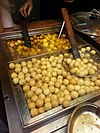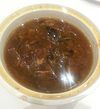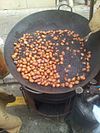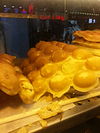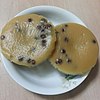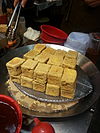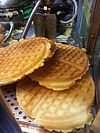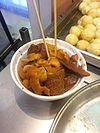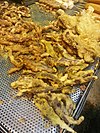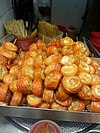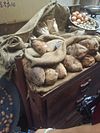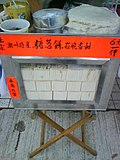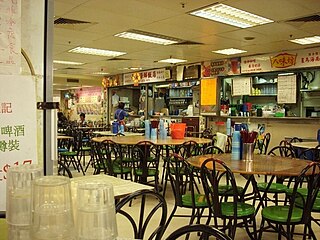
A hawker centre or cooked food centre is an open-air complex commonly found in Hong Kong, Malaysia and Singapore. They were built to provide a more sanitary alternative to mobile hawker carts and contain many stalls that sell different varieties of affordable meals. Dedicated tables and chairs are usually provided for diners.

A hawker is a vendor of merchandise that can be easily transported; the term is roughly synonymous with costermonger or peddler. In most places where the term is used, a hawker sells inexpensive goods, handicrafts, or food items. Whether stationary or mobile, hawkers often advertise by loud street cries or chants, and conduct banter with customers, to attract attention and enhance sales.

Dai pai dong is a type of open-air food stall. The term originates from Hong Kong but has been adopted outside Hong Kong as well. The official government name for these establishments is "cooked-food stalls". The more common name, dai pai dong, literally means "big licence stall" in Cantonese, referring to the stalls' license plates, which are larger than those of other licensed street vendors.

The Food and Environmental Hygiene Department (FEHD) is a department of the Hong Kong Government, reporting to the Environment and Ecology Bureau. It is responsible for food hygiene and environmental hygiene. It replaced part of the role of the Urban Council and the Urban Services Department, and the Regional Council and the Regional Services Department.

An egg waffle is a spherical egg-based waffle popular in Hong Kong and Macau, consisting of an eggy leavened batter cooked between two plates of semi-spherical cells. They are usually served hot, and often eaten plain, although they may be served with fruit and flavors such as strawberry, coconut or chocolate. It is referred to by its original Cantonese name, gai daan jai (雞蛋仔), and in English, an egg puff, bubble waffle, eggette, pancake balls, pancake waffle, egglet, and puffle. They are sometimes referred to as Hong Kong cakes in Chinatowns across America, especially in New York. One piece of egg waffle can have around 20 to 35 small round 'balls'.

Li Yuen Street East is a lane situated in Central on Hong Kong Island in Hong Kong. Its north-eastern end connects to Des Voeux Road Central and its southwestern tip joins Queen's Road Central. It is the first street which is named after a Chinese member of the society in colonial Hong Kong. Dubbed as the "Central’s Women Street", Li Yuen Street East is now a popular tourist spot with numerous stalls selling a wide variety of daily goods and souvenirs on the two sides of the street.
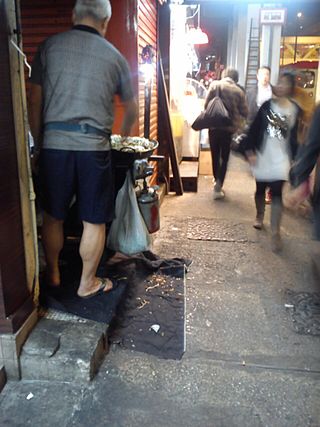
In Hong Kong, mobile stalls are used by the street hawkers to sell inexpensive goods and street food, like eggettes, fishballs and cart noodles since the 1950s. This style of selling is part of Hong Kong traditional culture. It reflects people’s ways of living and their spirits. In recent years, the operation of the mobile stalls faces challenges because of government policies and modernisation.
Dawn markets are street markets in Hong Kong which open early in the morning to evade the Food and Environmental Hygiene Department Hawker Control Teams. The goods sold are cheaper than other places. They are mainly run by the elderly and the homeless. Some sell products collected from bins or donated goods.

Tsing Yi Bamboo Theatre is an annual large-scale traditional Cantonese festival held in Hong Kong with a temporary built theatre which made with bamboos. It is located in Fung Shue Wo Road Football Field, which is next to Municipal Service Building in Tsing Yi, Hong Kong. It is for the celebration of Zhen Jun and Tin Hau.

Ngau zap or ngau chap is a Cantonese dish made of beef entrails.
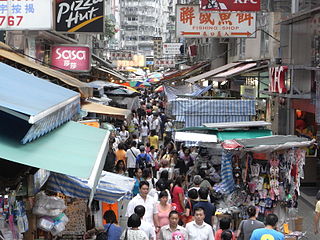
Hawkers in Hong Kong are vendors of street food and inexpensive goods. They are found in urban areas and new towns alike, although certain districts such as Mong Kok, Sham Shui Po, and Kwun Tong are known for high concentrations of hawkers.
Sham Shui Po Night Market, also known as Kweilin Night Market, refers to the temporary night market in Sham Shui Po, Hong Kong. It emerged during the Chinese New Year holiday in recent years and it is operated by hawkers who sell local street foods such as egg waffles, curry fish balls, steam vermicelli rolls and stinky tofu to festival goers. Since these hawkers are unlicensed, Sham Shui Po Night Market is considered illegal and therefore not tolerated by government authorities despite backlash from the supporting public. There is ongoing controversy over whether Sham Shui Po Night Market should be allowed to continue its operation or not.
Dai pai dong is a type of traditional food stall in Hong Kong. It was popular in Hong Kong during the 1960s and 1970s. The literal meaning of dai pai dong in English is “big license stall”. The characteristics of dai pai dong are a lack of air-conditioners, unclean environment, and various kinds of food. Starting from 1980s, the government stopped issuing new licenses and began buying them back. Due to its hygienic problem and the deaths of the license holders,most dai pai dong closed down and were replaced by different kinds of restaurants. Urban development has also had an impact on dai pai dong. There are only 25 dai pai dong left in Hong Kong according to the Food and Environmental Hygiene Department, which manages the licenses. Because of the desire to preserver the local food culture, it has been suggested that licenses should be issued again for new and existing dai pai dong owners.
Kweilin Street Night Market is a commercial and social activity in which unlicensed hawkers set up their mobile food stores and stalls to sell local street foods and groceries in Kweilin Street (桂林街), Sham Shui Po, Hong Kong.

Shoe shiners in Hong Kong are people who polish shoes on the street in Hong Kong for a living, mainly clustering on the pavement in Central, especially in Theatre Lane.
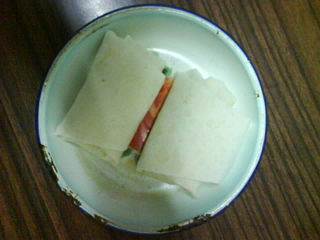
Traditional candy and coconut wrap is a traditional Cantonese snack. It is usually found on the street, where hawkers keep the wraps in a transparent metal box to sell. It is a wrap with hard sugar inside white wafer slice. It was especially famous in Hong Kong during the 1940s and 50s. The most popular fillings included shredded coconut, maltose and sesame.

Civil unrest occurred in Mong Kok, Hong Kong from the night of 8 February 2016 until the following morning. The incident escalated from the government's crackdown on unlicensed street hawkers during the Chinese New Year holidays. Eventual violent clashes broke out between police and protesters, resulting in injuries on both sides.
Night markets in Hong Kong are bazaars usually located in older areas like Sham Shui Po, Mong Kok or Sheung Wan. Besides selling toys, clothes and food, some Hong Kong night markets also provide divination to visitors, such as the Temple Street Night Market, which is popular with foreign visitors.
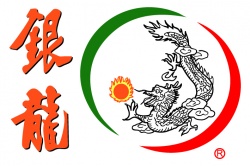
Ngan Lung Catering (Holdings) Limited is a cha chaan teng restaurant chain founded by Lau Choi Lung in 1963 in Hong Kong. The chain currently has 18 locations, primarily serving Kowloon and the New Territories. It also operates three restaurants on Hong Kong Island. Food items offered at each outlet varies, although most of the available food choices are standard, and are reminiscent of Hong Kong traditional cha chaan teng and bing sutt food culture.

The Yen Chow Street Hawker Bazaar, also known as Pang Jai (棚仔), is a covered market located at the intersection of Yen Chow Street and Lai Chi Kok Road in Sham Shui Po, Hong Kong. The market is known for selling fabrics, textiles, and other fashion-related paraphernalia. The market has been popular with craft enthusiasts, design students, and professionals in the fashion industry for decades.



